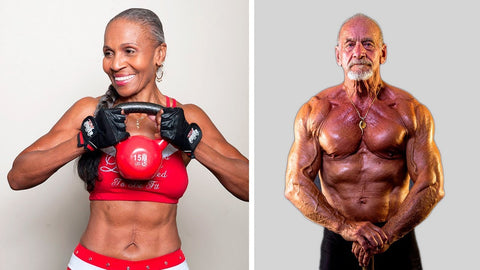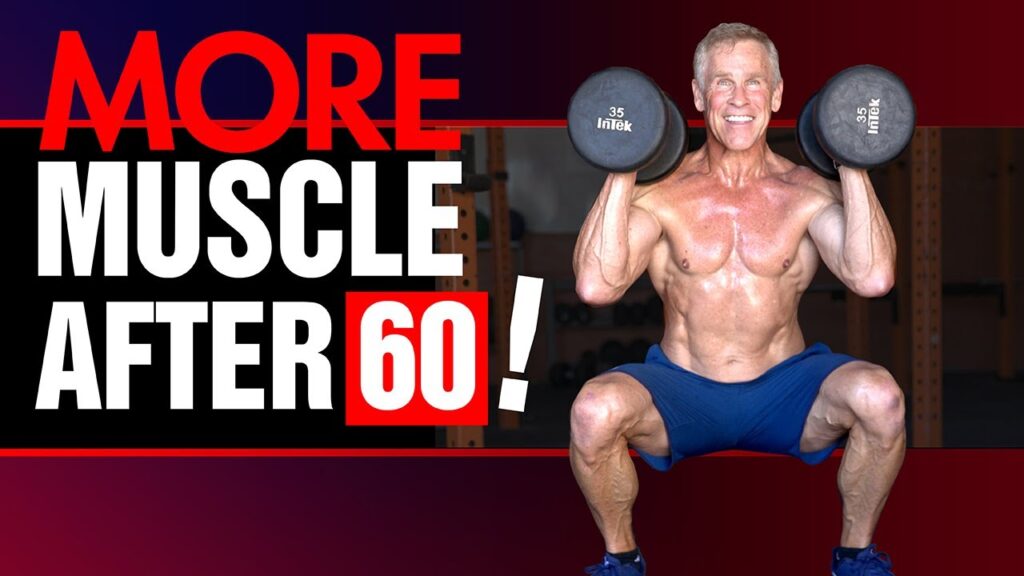Did you know that it’s never too late to start building muscle, even after the age of 60? Many people believe that as they get older, it becomes increasingly difficult to gain and maintain muscle mass. However, this notion couldn’t be farther from the truth. In this article, we will explore the possibility of building muscle after 60 and provide you with valuable insights and resources to help you combat Sarcopenia, the decline of muscle mass in older adults. So get ready to discover the secrets to staying strong and fit, regardless of your age!

This image is property of formmcr.com.
The Importance of Muscle Building After 60
As you age, maintaining optimal muscle health becomes increasingly important. Muscle building after the age of 60 offers numerous benefits that can help you lead a healthier and more fulfilling life. In this article, we will explore why building muscle after 60 is crucial and how it can prevent age-related muscle loss, improve functionality and quality of life, as well as boost metabolism and aid in weight management.
Preventing Age-Related Muscle Loss
One of the primary reasons why muscle building is essential after the age of 60 is to prevent age-related muscle loss, known as sarcopenia. Sarcopenia is a common condition characterized by the degeneration and loss of muscle mass, strength, and function. By engaging in regular muscle-building exercises, you can combat this natural process and preserve your muscle health for a longer period of time.
Improving Functionality and Quality of Life
Building muscle after 60 is not just about aesthetics or strength; it also enhances functionality and improves your overall quality of life. With stronger muscles, you can perform daily tasks more easily, maintain independence, and reduce the risk of falls or injuries. Additionally, increased muscle mass can improve bone density and joint stability, reducing the chances of developing conditions such as osteoporosis or arthritis.
Boosting Metabolism and Weight Management
As the body ages, metabolic rate tends to decline, making weight management more challenging. Building muscle after 60 can help counteract this slowdown by boosting your metabolism. Muscles are metabolically active tissues that require more energy, even at rest, compared to fat tissue. By increasing your muscle mass, you can enhance your metabolism and promote healthy weight management.
Factors Affecting Muscle Building in Older Adults
While muscle building is beneficial for older adults, several factors can impact the effectiveness of the process. It is important to understand these factors to make necessary adjustments and optimize your muscle-building journey.
Hormonal Changes
As you age, hormonal changes occur in the body, including a decline in testosterone levels in men and estrogen levels in women. Testosterone is a key hormone involved in muscle development, and reduced levels can hinder muscle growth. However, with proper exercise and a healthy lifestyle, it is still possible to build muscle and counteract the effects of hormonal changes.
Decline in Protein Synthesis
Protein synthesis, the process by which the body builds new proteins, becomes less efficient with age. This decline in protein synthesis can negatively impact muscle growth and repair. Older adults may require higher protein intake or specific strategies to optimize protein synthesis and promote muscle building.
Decreased Physical Activity
As individuals age, there is often a decrease in physical activity levels. This sedentary behavior can contribute to muscle loss and decreased muscle strength. It is crucial to engage in regular physical activity, including muscle-building exercises, to counteract this decline and maintain muscle health.
Poor Dietary Habits
Nutrition plays a vital role in muscle building and overall health. Older adults may have poor dietary habits, including insufficient calorie and protein intake. Adequate nutrition is necessary to provide the necessary building blocks for muscle growth and repair. Making positive dietary changes can significantly improve muscle-building outcomes.
The Role of Resistance Training
Resistance training, also known as strength training or weightlifting, is a cornerstone of muscle building, regardless of age. This type of exercise involves using external resistance, such as dumbbells, resistance bands, or weight machines, to work your muscles against resistance.
Benefits of Resistance Training
Resistance training offers numerous benefits for older adults looking to build muscle. It helps to increase muscle strength, improve balance and coordination, enhance bone density, and promote joint stability. Additionally, resistance training can have a positive impact on functional capacity, leading to improved mobility and overall quality of life.
Types of Resistance Training
There are various types of resistance training exercises that can be incorporated into your fitness routine. These include:
- Free weights: Exercises using dumbbells or barbells.
- Resistance machines: Specifically designed machines that provide resistance.
- Resistance bands: Elastic bands that offer resistance when stretched.
- Bodyweight exercises: Utilizing your body weight as resistance, such as push-ups, squats, or planks.
- Functional training: Exercises that mimic daily movements and improve overall functional fitness.
By diversifying your resistance training routine, you can target different muscle groups and maximize your muscle-building potential.
Frequency and Duration of Workouts
To achieve optimal muscle-building results, it is important to establish a consistent workout routine. Aim for at least two to three resistance training sessions per week, with a focus on different muscle groups during each session. Each workout should last around 45 minutes to an hour, allowing sufficient time for warm-up, proper form, and cool-down exercises.
Nutrition for Muscle Building
When it comes to building muscle, proper nutrition is just as important as exercise. The following nutritional considerations can enhance your muscle-building efforts and support overall health.
Adequate Protein Intake
Protein is the building block of muscles, making adequate protein intake crucial for muscle building. Aim to consume 1.2 to 2 grams of protein per kilogram of body weight per day. Good sources of protein include lean meats, poultry, fish, eggs, dairy products, legumes, and tofu.
Importance of Essential Amino Acids
Essential amino acids are the specific types of amino acids that the body cannot produce on its own and must be obtained through diet. These amino acids play a crucial role in muscle protein synthesis and muscle recovery. Consuming foods rich in essential amino acids, such as complete protein sources like animal products or combining plant-based protein sources, can support optimal muscle building.
Balancing Macronutrients
In addition to protein, it is important to maintain a balance of carbohydrates and fats in your diet. Carbohydrates provide the energy needed for workouts and facilitate muscle glycogen replenishment. Healthy fats, such as those found in nuts, seeds, avocados, and fatty fish, are essential for overall health and can support muscle-building efforts.
Choosing Nutrient-Dense Foods
Opt for nutrient-dense foods to maximize the benefits of your muscle-building diet. These foods are rich in vitamins, minerals, and other essential nutrients while being relatively low in calories. Examples include fruits, vegetables, whole grains, and lean protein sources.

This image is property of i0.wp.com.
Supplements for Muscle Building
While meeting your nutritional needs through a well-balanced diet is crucial, certain supplements can complement your muscle-building efforts. It is important to consult with a healthcare professional before incorporating any supplementation into your routine.
Importance of Consulting a Healthcare Professional
Before starting any new supplement regimen, it is important to consult with a healthcare professional. They can assess your specific needs and recommend supplements that are safe and suitable for you.
Protein Supplements
Protein supplements, such as whey protein powder, can be convenient for older adults who struggle to meet their protein requirements through food alone. These supplements provide a concentrated source of high-quality protein that can support muscle recovery and growth.
Creatine
Creatine is a naturally occurring compound that plays a role in providing energy to the muscles during exercise. Supplementing with creatine has been shown to increase muscle strength and power, particularly in older adults.
Beta-Alanine
Beta-alanine is an amino acid that helps reduce muscle fatigue and improve endurance during high-intensity exercise. It can be beneficial for older adults who engage in resistance training and high-intensity workouts.
Omega-3 Fatty Acids
Omega-3 fatty acids, found in fish oil supplements, have anti-inflammatory properties and can support muscle recovery and reduce exercise-induced muscle soreness. They also offer numerous other health benefits for your heart, brain, and overall well-being.
Vitamin D
Vitamin D plays a crucial role in maintaining bone health and muscle function. Older adults may have lower levels of vitamin D due to decreased sun exposure. Supplementing with vitamin D can help support muscle health and overall mobility.
Recovery and Rest
Proper recovery and rest are essential components of any muscle-building program. They allow your muscles to repair and grow, maximizing the benefits of your workouts.
Allowing Sufficient Rest between Workouts
Muscles need time to recover from the stress of resistance training. Aim for at least 48 hours of rest between exercise sessions targeting the same muscle group. This rest period allows for muscle repair and growth, reducing the risk of overtraining or injury.
Importance of Quality Sleep
Sleep plays a critical role in muscle recovery and overall health. Aim for seven to nine hours of quality sleep each night. During sleep, the body releases growth hormone, which is crucial for muscle repair and growth. Prioritize good sleep hygiene practices, such as maintaining a regular sleep schedule and creating a comfortable sleep environment.
Incorporating Active Recovery Techniques
In addition to rest and sleep, incorporating active recovery techniques can aid in muscle recovery. These techniques include low-intensity exercises such as swimming, walking, or yoga, which promote blood flow, reduce inflammation, and alleviate muscle soreness. Active recovery can help optimize your muscle-building journey and reduce the risk of overuse injuries.

This image is property of cdn.shopify.com.
Addressing Motivation and Mental Well-being
Building muscle after 60 requires dedication and consistency. However, addressing motivation and mental well-being is equally important to sustain your progress and enjoyment of the process.
Setting Realistic Goals
Set realistic and achievable goals to stay motivated and track your progress. Consider both short-term and long-term goals, and break them down into smaller milestones. Celebrating these smaller victories along the way will help maintain momentum and keep you focused on your larger objectives.
Finding Enjoyable Activities
Choose activities and exercises that you enjoy. Building muscle doesn’t have to be limited to traditional weightlifting; there are numerous options available. Explore activities such as swimming, dancing, hiking, or group fitness classes that combine resistance training with social engagement. Finding enjoyable activities will make your workouts more enjoyable and increase your adherence to your fitness routine.
Seeking Support from Peers or Professionals
Seek support from peers or professionals to enhance motivation and ensure that you stay on track with your muscle-building goals. Consider joining exercise groups, finding a workout buddy, or working with a personal trainer. Having a support system can provide encouragement, accountability, and expert guidance, ultimately leading to better outcomes.
Working with a Personal Trainer
Working with a personal trainer can provide significant benefits for older adults looking to build muscle. Here are some advantages of having a personal trainer:
Benefits of Having a Personal Trainer
Expert guidance: A personal trainer can design a customized workout program tailored to your individual needs and goals.
Proper form and safety: A trainer ensures that you perform exercises with the correct form, minimizing the risk of injury.
Accountability and motivation: A trainer keeps you accountable and motivated, pushing you to reach your full potential.
Progress tracking: A trainer can monitor your progress and make necessary adjustments to your workouts for optimal results.
Working with a personal trainer can provide the knowledge, support, and guidance needed to build muscle effectively and safely.
Tailoring Exercises to Individual Needs
A personal trainer can assess your fitness level, mobility, and any pre-existing conditions to tailor exercises that suit your unique needs. They can modify exercises, provide alternative options, or incorporate specific techniques to accommodate your abilities and maximize your muscle-building potential.
Ensuring Proper Form and Safety
Proper form is crucial during resistance training to target the intended muscles and prevent injuries. A personal trainer can guide you on correct exercise technique, ensuring that you maintain proper form and alignment. This attention to form and safety reduces the likelihood of strain, overuse injuries, or accidents.

This image is property of i.ytimg.com.
Overcoming Challenges and Managing Risk
Building muscle after 60 may come with certain challenges and risks. However, with the right approach, these obstacles can be overcome while prioritizing safety and overall well-being.
Dealing with Injuries or Chronic Conditions
If you have pre-existing injuries or chronic conditions, it is important to work with a healthcare professional or physical therapist to develop an exercise plan that accommodates your specific needs. They can suggest modifications, exercises, or rehabilitation techniques that can aid your muscle-building journey without exacerbating any existing conditions.
Gradual Progression and Adaptation
Gradual progression is key to building muscle effectively and minimizing the risk of injury. Start with a weight or exercise intensity that challenges you without overwhelming your abilities. As you become stronger, gradually increase the weight or intensity to continue stimulating muscle growth.
Monitoring Heart Health
Before starting any new exercise program, individuals with cardiovascular conditions should consult with their healthcare provider. Monitoring heart health is essential to ensure that you can engage in resistance training safely. Regular check-ups and communication with your healthcare team will help manage any potential risks and make informed decisions regarding your exercise routine.
Testimonials and Success Stories
Inspiring stories from older adults who have successfully built muscle can provide motivation and encouragement on your own muscle-building journey. These stories demonstrate that age is not a barrier to achieving impressive results and highlight the positive impact lifestyle changes can have on overall health and well-being.
Inspiring Stories of Older Adults Building Muscle
Inspirational stories can be found within communities and online platforms dedicated to promoting active and healthy aging. These stories showcase individuals who, through dedication and perseverance, have transformed their bodies, improved their strength, and experienced a higher quality of life.
How Lifestyle Changes Made a Difference
Many success stories attribute their muscle-building achievements to effective lifestyle changes. By incorporating regular exercise, following a balanced diet, prioritizing recovery, and addressing mental well-being, individuals have not only built muscle but also experienced significant improvements in overall health and vitality. These stories serve as a reminder of the transformative potential that muscle building can have in older adults’ lives.
In conclusion, building muscle after the age of 60 is crucial for preventing age-related muscle loss, improving functionality and quality of life, as well as boosting metabolism and aiding in weight management. By understanding the factors that affect muscle building in older adults, incorporating resistance training, focusing on nutrition and recovery, addressing motivation and mental well-being, and seeking professional guidance when needed, you can effectively build muscle and enjoy the numerous benefits it offers. The testimonials and success stories of older adults who have experienced firsthand the positive impact of muscle building serve as a reminder that it is never too late to prioritize your muscle health and lead a vibrant and active life.



